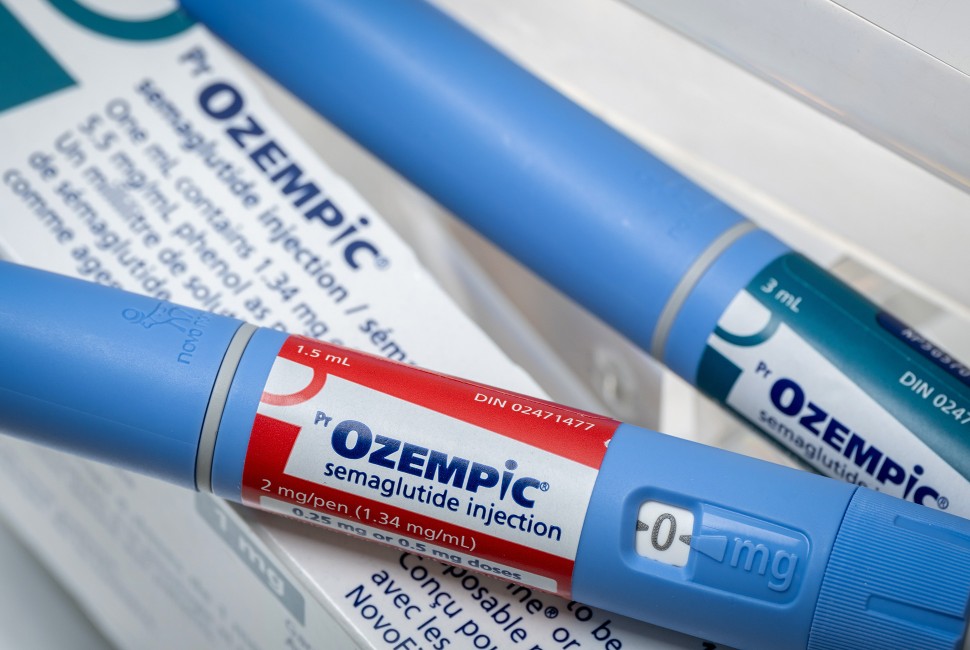About Ozempic/Mounjaro/Wegovy
I’ve been asked about my thoughts quite a lot recently, so here are my two cents on the new craze for GLP-1s/semaglutide/tirzepatide.*
Well, that’s the thing, weight loss jabs are not that new, but have blown up in popularity over the year or so.
Ozempic and Wegovy are GLP-1 agonists and contain a synthetic chemical which mimics the hormone glucagon: glucagon-like peptide 1 (i.e. GLP-1). Mounjaro is a dual agonist, which means it mimics another hormone as well as GLP-1, which is GIP (glucose-dependent insulinotropic polypeptide).
These cost about £180-£220 for one treatment course here in the UK.
There is no doubt that tirzepatide/semaglutide works and I believe it is a powerful tool that can be used to help people shift large amounts of weight.
How they work
The reality? Mounjaro, Ozempic and Wegovy essentially put users into a significant calorie deficit – they eat much less food (due to decreased appetite, slower digestion, more satisfaction after eating and better insulin regulation) and drop weight fast as a result. The powerful impact comes also from the reported drugs’ impact on our desire for food. I’ve listened to copious accounts of people who have taken the drug, as well as spoken to people personally who’ve taken it, and they all report the idea of ‘food noise’ (or other ‘addiction’ noises) quietening. Finally they’re not thinking about food in some capacity all day; they’re finding they’re more akin to that friend we have who says they’ve simply ‘forgotten’ to eat breakfast and lunch.
The drug has notable potential for those struggling with addictions/bad habits, food of course being one of them. Habits which tend to be linked to coping with stress and seeking dopamine rushes, such as alcohol and substance abuse, gambling and online shopping. Ozempic/Mounjaro/Wegovy interact with a region of the brain called the mesolimbic system, which overlaps with the brain processes that dictate addictive behaviours.
It’s important to note that there are of course downsides – no medication is without its side effects and a lot of people are taking the drug in a nonsensical way. Micro-dosing (according to your body’s metrics) is the best way to take the agonists, but most people take a one-size-fits-all dose (fault of the drug companies) which does not fit all, as we are not all the same. Visible side effects commonly found by people who take too much include: nausea/being sick, abdominal pain, fatigue, constipation and diarrhoea, and side effects around internal health include: severe hypoglycaemia (low blood sugar) and hyperglycaemia (high blood sugar) and vision issues. Visually, people develop wrinkles, sunken eyes, a gaunt look, thinner lips and sagging skin.
Absolute non-negotiables to stay healthy while taking GLP-1 agonists
If you decide to take the drug, there are some things you cannot compromise on while you’re doing so:
Strength training. Being on a GLP-1 agonist means you drop weight fast, but about 40% of the weight lost will be muscle mass if the body is left to its own devices (muscle is a tissue that requires a lot of calories to maintain – it’s ‘expensive’ – so the body will try to get rid of it first). This is incredibly detrimental as having muscle mass and strength has been shown in copious studies to categorically be the most important thing for longevity, health and successful aging. Muscle IS medicine. You absolutely have to be lifting heavy, to retain your muscle mass and prevent osteoporosis as much as possible. You won’t build muscle as your calories will be too low – the strength training is about preservation.
Some people report a general apathy feeling towards lots of things when on the drug (linking to the muting of desire I mentioned earlier), which can make motivation to workout hard. But remember, in this case it’s not about waiting for motivation, it’s about dedication!
A High protein diet. That’s hitting 2g per kg body weight every single day. Sadly, we don’t store protein, so it’s not a case of averaging over the week.
Without heavy, regular strength training and a high protein diet, you will end up as what’s known as ‘skinny fat’ – i.e. slim, but having very little muscle mass/’tone’. This leaves you metabolically busted and does your future self a massive disservice. Having less muscle comes with it’s own health problems – you’ll become frail, deteriorate quicker and become significantly weaker, meaning your quality of life will decrease as you’ll be less physically able. Using the drug without these measures means you’ll come out the other side in a worse position than when you started, which sets you up to be yo-yoing on and off the drug for years/the rest of your life and having to eat even less as time goes on.
Work on your attitude to food. GLP-1 agonists can be very powerful at helping alter behaviours to food while the drug is taken. However, this is the time you also need to work hard on figuring out the root causes of your poor relationship with food. Ideally, do therapy at the same time. Obesity is interlinked with mental health – there are often deep-rooted reasons why people overeat. This links to point 2! Don’t let GLP-1s be a temporary relief/plaster.
Eat well when you do eat. Yes, you could just eat one share bar of Dairy Milk for your days’ food and feel full, but you’ll feel terrible and you’re not fixing the deeper issue of how and why your eating habits got you to the point of being overweight. If you’re eating barely anything, micronutrients have to be one of the top priorities. This ties in with point 2.
My thoughts
When taking the drug I think it’s vital to make use the mental clarity you’ll have for improvement of future you (who isn’t on the drug). If you don’t, I believe you’re setting yourself up for failure and reliance on the drug. It’s the same if using it for addictions – without addressing WHY you get urges to drink and compulsively online shop etc., these desires will only come right back once the drug has worn off. Boots appears to be offering programmes and coaching alongside the drug, which is a great step.
Overall, I am still learning a lot about GLP-1s, but I can safely say that I don’t think they’re ‘cheating’. They’ve got extremely powerful uses for those in real, immediate need (obese patients who’s high body fat puts them at serious health risks). But, you can’t deny that having a drug dictate your weight loss means you’ve not gone through the emotionally difficult journey, self-education, lessons learned and hardship that ‘normal’ fat loss entails. These drugs reiterate that it’s the PROCESS which people are desperate to skip, but that’s the part which ensures you’ll keep the weight off sustainably in the future. It’s why studies show those who fad diet come back with much more body fat than they did before – it’s because they have not learned about nutrition and the science of how we lose fat… how can you maintain something you don’t understand? Without education on top of the GLP-1s, you’re throwing money at a problem that is likely to keep coming back.
*I must clarify, I am not a doctor or trained to give out medical advice. This article is about my opinions of the drugs and courses of action that must be taken alongside taking the drug, based on the research I have done.

